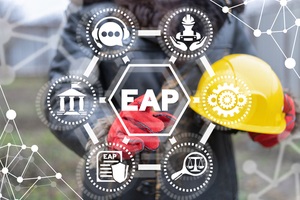 Anxiety and depression have a substantial economic impact, according to the World Health Organization, resulting in an estimated cost to the global economy of more than $1 trillion each year in productivity loss. The COVID-19 pandemic, along with other environmental stressors, has had a negative impact on employee well-being and overall performance.
Anxiety and depression have a substantial economic impact, according to the World Health Organization, resulting in an estimated cost to the global economy of more than $1 trillion each year in productivity loss. The COVID-19 pandemic, along with other environmental stressors, has had a negative impact on employee well-being and overall performance.
Employee assistance programs (EAPs) are voluntary, employee benefits programs that offer free and confidential assessments, follow-up services, referrals and short-term counseling to employees experiencing personal and/or work-related problems. An EAP should address a range of issues that affect a person’s mental and emotional health, such as stress, substance abuse, family problems, grief and psychological disorders.
Learn more about employee assistance programs, common delivery models, and how to properly develop and implement an EAP model within an organization:
What Is an Employee Assistance Program (EAP)?
EAP programs are offered by employers to help employees resolve a broad range of problems impacting their lives before they have the chance to interfere with work performance. Some of the most common issues that EAPs help employees address include the following:
- Financial struggles
- Marital problems
- Family issues
- Mental health imbalances or disorders
- Substance abuse
- Emotional problems
Many employee assistance programs offer other valuable services to employees, such as adoption assistance, marital counseling, elderly care services, childcare, health and wellness programs and more. Employers that offer EAPs often see an array of advantages, such as improved employee retention and increased job satisfaction.
Employee Assistance Program Delivery Models
There are several different delivery models that employers should consider before establishing an EAP. These include:

- Fixed-Fee Delivery Model – This type of delivery model is best suited for small- and mid-sized businesses. Fixed-fee models allow businesses to pay a set fee for a specific selection of EAP services. This fee is generally determined by the services selected and the number of employees within the organization.
- In-House Delivery Model – Large companies or corporations may choose to hire an in-house EAP specialist to provide on-site or remote services to the business. In-house delivery models often involve a fixed fee and enable employees to access an EAP professional at any time.
- Contract-Only Services Delivery Model – Under a contract-only services delivery model, organizations contract with EAP professionals to deliver services only when needed. Businesses are then charged on a contract or ad hoc basis. Contract-only services models are best suited for startups and small businesses.
- Hybrid Delivery Model – Hybrid delivery models may include a variety of contract-only services, fixed-fee services and membership or union-sponsored services. This type of delivery model is a great option for organizations that are looking for a range of services for a fixed fee while having the option to contract out additional services if needed.
- Membership- or Union-Sponsored Services Delivery Model – Employees that are part of a member assistance program or union, based on their industry or affiliations, may benefit from choosing a membership- or union-sponsored services delivery model.
How to Develop and Manage an Employee Assistance Program
The first step in developing and implementing an EAP for an organization is identifying what employees need. Analyze the current benefits offerings to see what areas have been found valuable by employees and what areas are lacking. Remember that today’s employees have higher expectations and are more likely to look for work elsewhere when their needs are not being met.
There is no one-size-fits-all approach when it comes to developing and managing an employee assistance program. The following tips can help businesses more effectively implement an EAP model within their company.
1. Gather Participants to Form an EAP Committee
Creating a team of driven participants can help ensure that the employee assistance program is created and implemented with accuracy and attention to detail. An EAP committee could include members of leadership, human resources (HR), management or a mix of employees from different departments. Smaller businesses may need to keep their committee relatively sparse but larger companies may have the workforce needed to create a larger EAP committee.
2. Choose the Right EAP for the Organization
Carefully review the different types of EAP delivery models to determine which is right for the organization. Larger companies can often benefit from maintaining on-site services, while a hybrid model gives organizations struggling to make a decision more flexibility and customization.
3. Develop an EAP Policy Backed by Data
The next step in developing an EAP involves compiling data, statements and other information needed to support the organization’s desire to create an employee assistance program. Before moving forward, have the policy reviewed by partners and stakeholders.
4. Search for and Compare EAP Providers
 Once the EAP policy has been reviewed and approved, the business can move on to searching for an experienced EAP provider. Professional services can be found available on an in-house or contract basis. Take the necessary steps to get the EAP services prepared for employees, which includes drafting any necessary agreements or contracts.
Once the EAP policy has been reviewed and approved, the business can move on to searching for an experienced EAP provider. Professional services can be found available on an in-house or contract basis. Take the necessary steps to get the EAP services prepared for employees, which includes drafting any necessary agreements or contracts.
5. Share the News of an EAP with the Entire Team
Make a company-wide announcement that provides employees with all of the details of the new employee assistance program. This news can be shared in a variety of ways, such as through email or a corporate newsletter. Provide human resources with guidelines on the EAP to ensure they are able to address any questions or concerns that may arise.
6. Regularly Review the Program’s Progress
Even after an employee assistance program has been developed and implemented, it will need to be continually managed and reviewed. Take note of how often employees are using these services and continue to communicate new services to the workforce. Some businesses may find the need to adopt different EAP delivery models in the future to cut costs.
Speak with a Reputable Business Benefits Consultant
Employee assistance programs can provide organizations with many benefits, such as better stress management, decreased absenteeism, greater employee retention and reduced workers’ compensation claims. Interested in learning more about how to develop and manage an employee assistance program? Contact the experienced business benefits consultants at Business Benefits Group to get started today.


